By Sean Fagan

A photo with a haunting, terrible beauty. In the midst of this raging forest fire in Montana, two elk deer sought refuge in a river. From this photo - it's easy to get a sense of the immense destruction, heat and danger caused by a rapidly spreading forest fire (Photo: Wikimedia Commons).
.
8 Safety Tips on Using a Campfire in a Dry Woodland
.
During the summer and autumn of 2017, the country of Portugal suffered dreadful forest fires, with over 100 fatalities and many thousands of hectares of woodland burnt and charred.
2017 was also the worst year of recorded forest fires in the Canadian province of British Columbia. Over 890,000 hectares of forest burnt, caused by over 2,000 individual fires.
It's an obvious fact - fire hazards in dry woodlands are incredibly real.
Both the woods of Canada and Portugal possess tree species that are particularly flammable, such as pine trees.
But many dry woodlands do not contain coniferous trees and are often extreme fire hazards (especially during prolonged dry periods).
Considering they can move at a lively clip of almost 7km per hour and can reach a staggering 800 degrees Celsius - forest fires are an awe-inspiring and immensely destructive force of nature.
Wherever we camp we owe it to the land we are using to take good care of it.
With these terrible forest fires in recent memory I've come up with 8 fire safety tips that I believe every campfire-user should follow in dry woodlands.
.
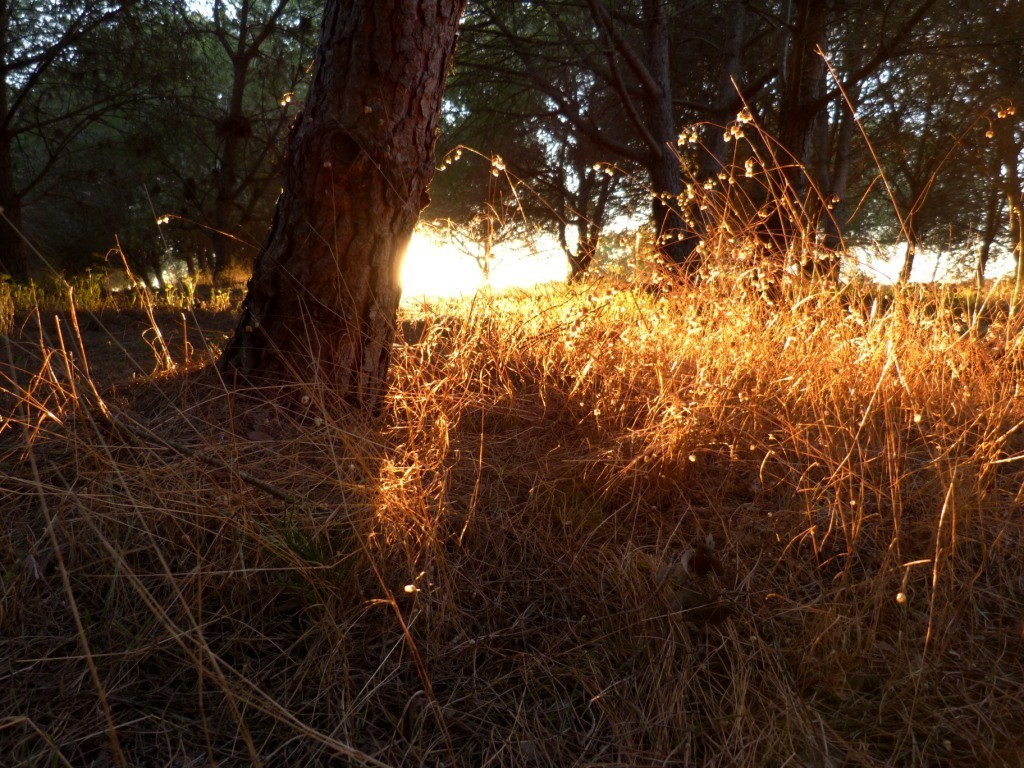
The pine and oak woods of Portugal where I camped recently are incredibly dry. A dropped cigarette, a spark from a campfire, even a glass bottle exposed to the sun is all it takes for a fire to start here (Photo: Sean Fagan).
.
About a month ago I was camping in a Portuguese woodland which mostly consisted of coniferous tree species.
It's very hard to convey to you, the reader, how bone-dry these woods were.
From talking to some Portuguese locals over the course of my visit I was repeatedly told the same story about the weather - that this winter was very dry.
Some of them conveyed this information with a sense of dread.
And with little wonder - with the dreadful forest fires of 2017 still fresh in the memory of the Portuguese people - it's easy to sense that a repeated bout of destructive forest fires was on the minds of many.
.
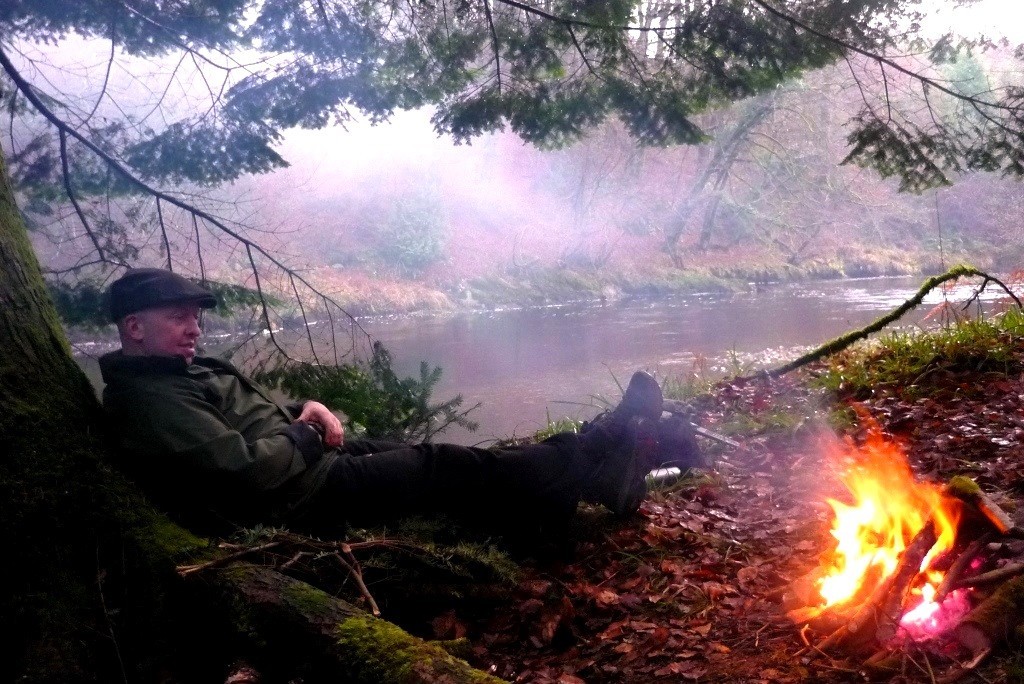
I often locate my campfire beside water. Besides the nice scenery and wildlife associated with wild water, it's also very convenient for dousing out my fire (Photo: Sean Fagan).
.
Without the slightest exaggeration, dry woodlands are akin to a giant tinder bundle awaiting the slightest flame to be transformed into a blazing inferno.
Without further ado, here is 8 safety tips for dry woodlands:
(*This following list is not a comprehensive list but will go a long way in preventing forest fires).
.
1. Where? The location of your campfire is vital - in photo below, I selected a spot near a marsh where there was plenty of water to properly extinguish my campfire after I was finished, or if my fire got out of hand.
.
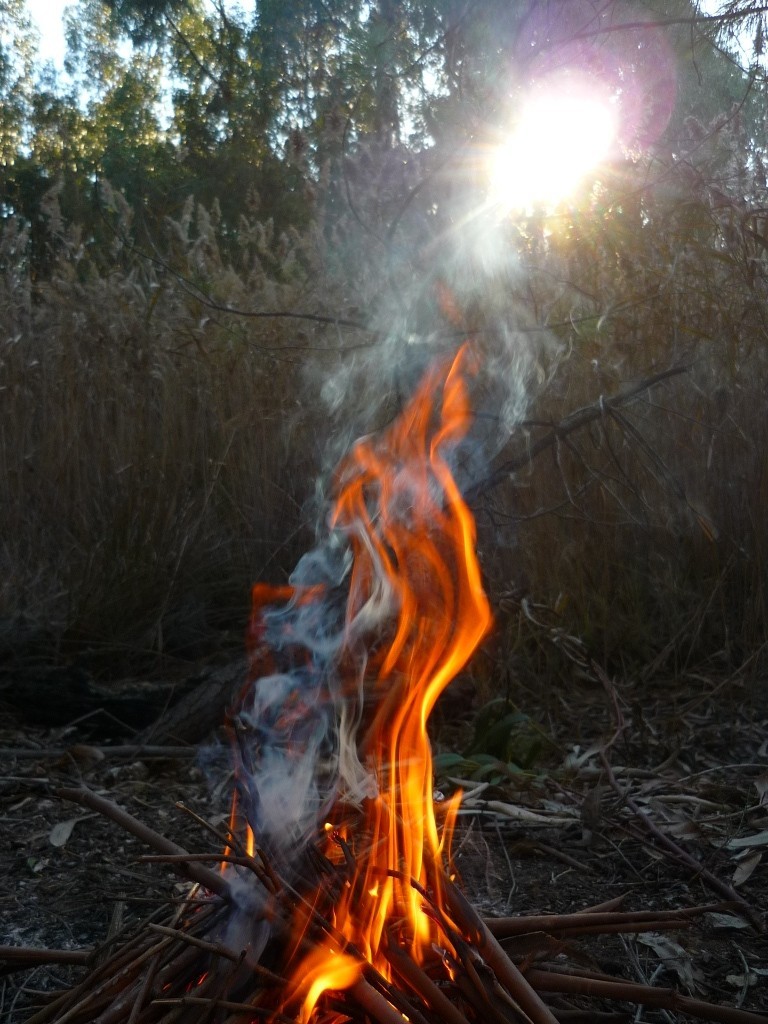
When I was camping in a Portugal about a month ago, I would occasionally burn the flammable bark of the non-native eucalyptus tree to deter mosquitoes. EXTREME caution was required (Photo: Sean Fagan).
.
If you plan on camping in woodlands and using campfires then I would recommend situating your campsite near water - but finding water sources can be challenging in dry countries. This is where pre-trip research comes to the fore.
Google Earth satellite images are a good start as is availing of accurate, topographical maps (remember, water bodies are often seasonal/temporary in dry countries). What you're mostly looking for is conspicuous bodies of water such as rivers and lakes. Also, consider camping near the sea or alongside other watery habitats like estuaries or marshes/swamps. Even camping near a pond is better than nothing, something I've done a few times.
One of my favorite type of wild campsite is where fresh water meets saltwater - where a river meets the sea. I have fresh water for drinking, fishing and dousing out my fire and the sea for swimming, foraging and hanging out. If the area is also forested - I have the best of three worlds (sea, river and woodland). I couldn't be happier.
These kind of fantastic campsites are best sought out on a map long before setting foot on land (again, pre-trip research is often required - if not essential).
Final tip: consider lighting your campfire on bare rock. Okay, I'm about as enthusiastic about leaving an ugly fire scar on rock as getting my welly boots stuck in mud, but it might be the better, safer choice.
Lighting a fire on a sand or gravel bank alongside a river are other good options.
.
2. On what? Clear away at least a 1 metre square area for your campfire. Remove all leaf debris, twigs…everything, so that your campfire is sitting on bare soil. Dead leaves in dry woodlands are often flammable.
Avoid lighting a fire on turfy soils (organic soil). This type of soil is often found near or on marshy/boggy areas. They can be a smouldering time-bomb. Can easily smoulder for days, if not weeks, before igniting a woodland or grassy area.
What you're looking for is mineral soil to light your fire on. The majority of soil in woodlands is mineral soil but it's always a good idea to know the difference between mineral and organic soil.
.
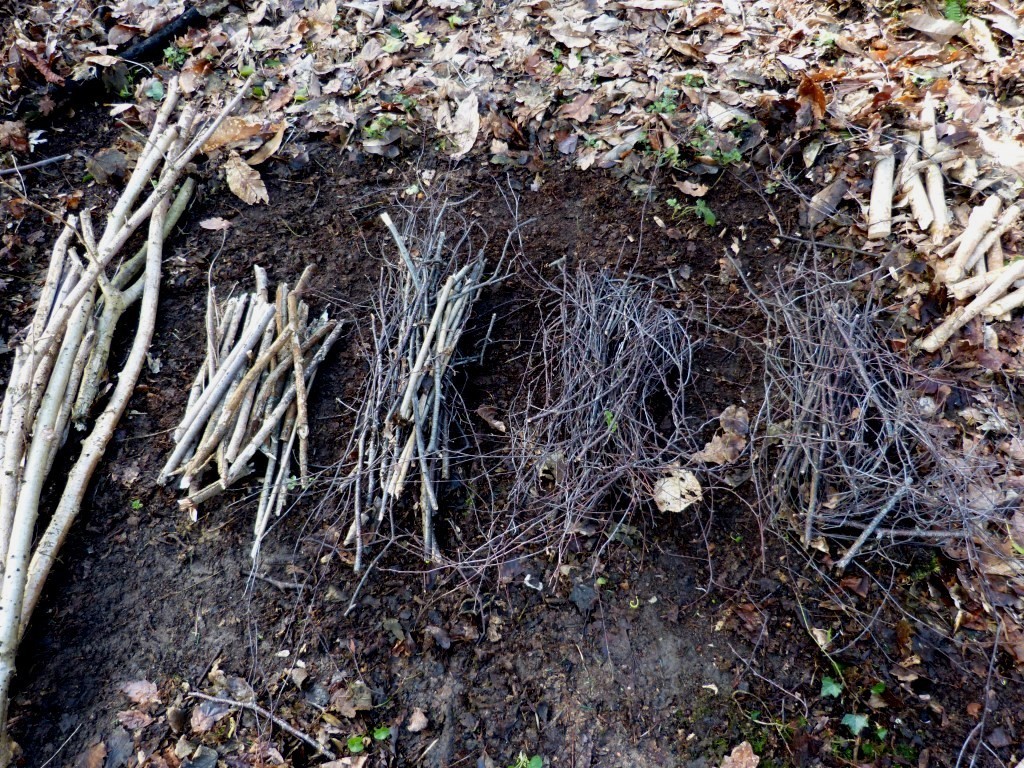
Campfire preparation with various thickness of kindling and fuel. You can see the cleared area under the fuel and kindling - that's what you're aiming for in dry woodlands. A cleared area, about 1 metre square (or more), with all woodland debris removed (Photo: Sean Fagan).
.
3. Don't be a Bright Spark: Never burn sparky fuel. Some types of wood can throw out sparks when burning - avoid them if possible. All it takes is one unnoticed spark to set a wood ablaze.
Good examples of sparky woods are locust, mulberry, osage, sweet chestnut and many coniferous trees species such as hemlock, spruce, pine and cedar (which all contain significant amounts of volatile, flammable resins).
.
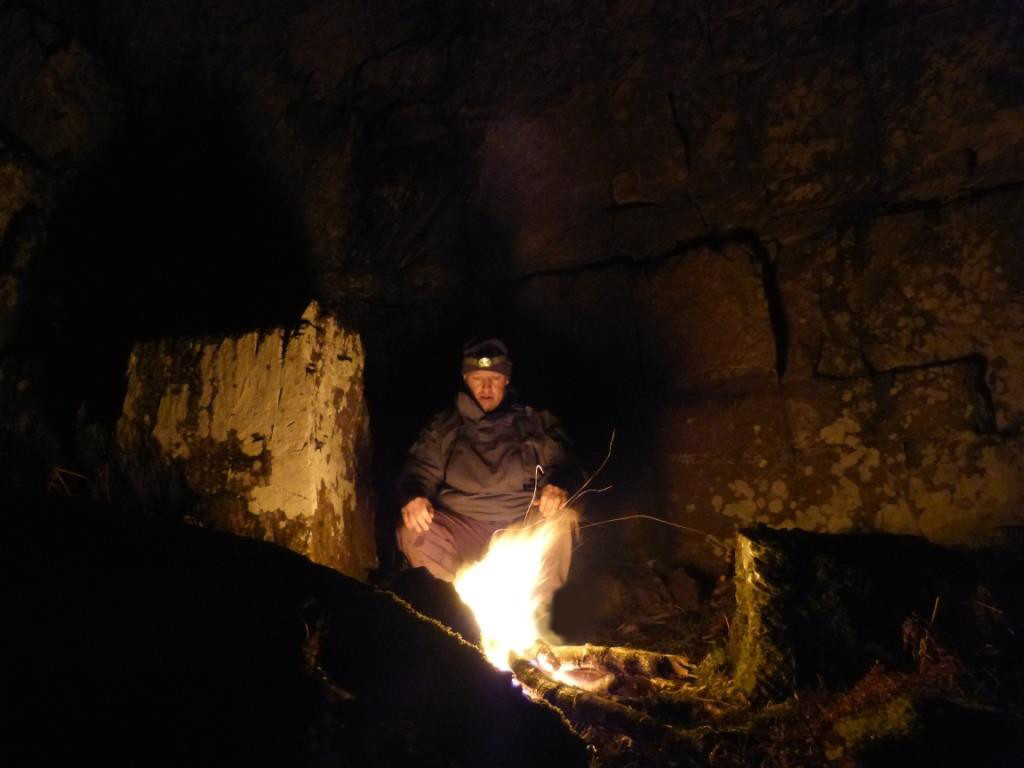
You can see from this photo, some sparks trails shooting out from my campfire. This kind of campfire is generally safe in the generally damp conditions of where this photo was taken (Ireland) but is unacceptable in a dry woodland (Photo: Sean Fagan).
4. What is left? I always aim to burn my campfire to a fine ash - no potentially flammable, partially-charred logs were left behind - just too risky. This requires a little foresight – it's a good idea to know how long you want to burn a campfire for (so you can burn all fuel to a fine ash).
A campfire consisting of fine, hot ash is a lot easier to extinguish that a campfire consisting of partially burnt logs. What this entails is carefully tending to an ever-diminishing campfire as the last of your fuel burns to ash.
.

Nearly there. In photo, you can see how this campfire is well on the way to being burned to ash (Photo: Sean Fagan).
.
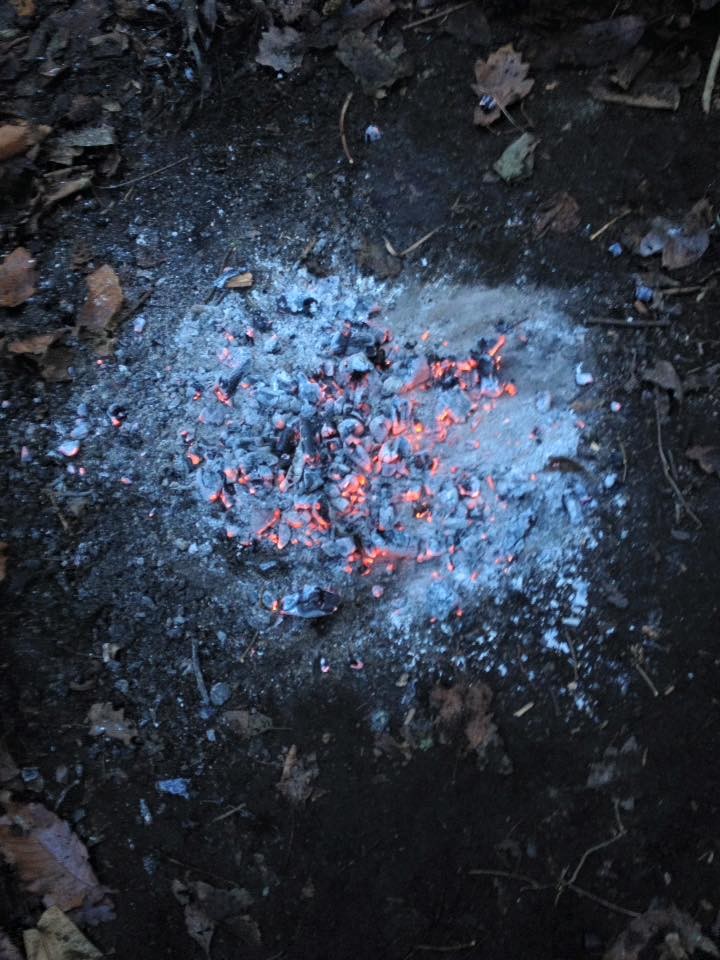
About 30 minutes later, and my campfire was almost burned to ash. Excuse photo quality (Photo: Sean Fagan).
.
5. How much water to put out a campfire? The reality is - the margin for error as regards fire risks in a dry woodland is far, far less than say - fire risks in damper woodlands (certainly the case in my home country of Ireland – a country of almost perpetual dampness). With this in mind, a lot of water is needed to properly douse out a campfire in a dry woodland.
Essentially, the first 4-6 inches of soil under a campfire should be saturated with water. That’s a lot of water. Think litres of water rather than millilitres. This is why a campfire located near a water source is so much more preferable and safer.
6. Poke some holes into the soil: After the fire has been thoroughly extinguished then its time to take care of the soil under the campfire, which can still retain a lot a heat. A good tip is to poke a lot of holes, a couple of inches deep, into the soil under the extinguished campfire. A small wooden stake or sturdy stick will do the job just nicely.
Pour plenty of water into the holes. This simple practice facilities the entry of water into the soil, eliminating any heat from the soil.
7. Then mush it all about: So, your fire has been extinguished with plenty of water, and numerous small holes were poked into the extinguished fire site which had water poured down them. Now it's time to mush up the soil surface a bit to release any trapped heat.
This can be done with the wooden stake or stick that was used to poke holes into the soil. As the soil is being mushed up, it's a good idea to periodically add water.
What you’re ultimately aiming for is a sodden mass of fire ash and soil. Nothing less.
8. Leave no Trace? Often, its desirable to camouflage the remains of our campfire site with surrounding debris from the woodland floor (such as dead leaves). A quick tip: thoroughly soak any dead leaves and woodland debris with water and then place upon your fully doused fire site.
If in doubt, continue to add water. By soaking the leaves there is far less of a fire risk.
.That's it.
Seems like overkill?
No, not really.
Using a campfire is a privilege that comes with a certain amount of responsibility.
As bushcrafters and outdoor enthusiasts we may forage a little, burn some wood, carve a little...but overall we should seek to minimise our effect on the woods.
We simply owe it to the trees, the plants and all the wild animals that inhabit woodlands to leave them alone, unscathed.
To visit, admire and cherish but never to waste and destroy.
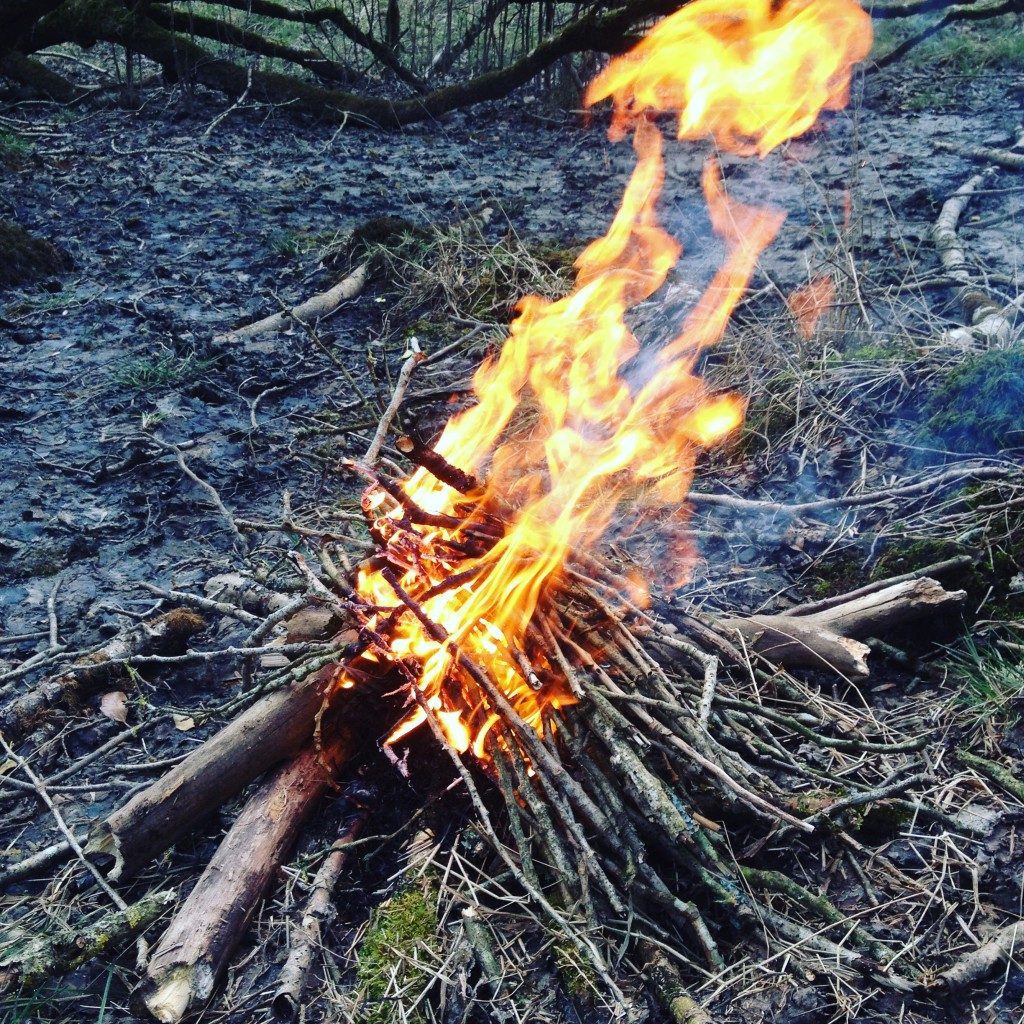
Above all, enjoy the benefits of a safe campfire. One of my greatest pleasures in life is sitting before a campfire - just listening and watching the world around me. A simple, timeless pleasure (Photo: Sean Fagan).
.
"Fire’s the sun, unwindin’ itself out o’ the wood" ~ David Mitchell
.
..
.Related Articles on this Website:
- Quick Fire-Starting Tip
- Camp-Craft: The Bushcraft Virtues of Smokey Fires
- Brief Homage to the Campfire
.
*Check us out on Instagram, Twitter & Facebook for more outdoor-related topics..
.
Additional Reading:.
To Light a Fire or...to not Light a Fire
.
Here is one option - don't light a fire.
When you think about it, a campfire is often not needed in hot/warm climates.
Granted, a campfire is good for sterilizing drinking water, deterring biting flies, cooking, keeping warm during chilly nights and even keeping dangerous predators at bay (e.g. hyenas in Africa are notorious camp predators).
But it’s perfectly possible to bring food that does not need to be cooked and biting flies can easily be deterred by wearing clothes and insect repellent.
Chilly nights are best remedied with insulating clothing.
Out of the above list, the only one that is anyways necessary on a daily basis is purifying water but even purifying water by boiling over a campfire is questionable - as you could use a millbank bag and a portable water purification device/or chemical means of purification.
So it's perfectly possible to camp in a dry woodland with no need or very little need of a campfire.
.
One solution is to bring your own fuel and heat, i.e. a portable camping stove. These are a much safer and more discreet way of cooking food and purifying water than an open campfire.
Another solution to situate your campfire out in the open - away from the potential fire hazards of woodlands.
When practical and safe this is a good solution.
I’ve often camped in woodlands but situated my campfire a good distance away, out in the open, as I felt that using a campfire in the woods was too hazardous.
What I’m trying to encourage is an open-minded, flexible approach to safe, campfire use in dry countries.
I really urge you to err on the side of caution and trust your gut. If the area feels like a ticking firebomb about to go off…then leave and find a spot that feels safe.
All it often takes is a quick examination of the leaf litter and surrounding vegetation to confirm your suspicions. If the dead leaves on the woodland floor and the dead twigs still attached to standing, living or dead trees feel very dry, even dry to the point of being brittle, then caution is the order of the day.
And if you decide to light a fire in a dry woodland then follow the 8 fire safety points of this article.
.
Dry Woodlands can occur in Damp Countries:
.
In this article I used my camping experiences in Portugal as a good example of dry woodlands that are a fire hazard.
The reality is, pretty much any woodland is a fire hazard if dry enough.
In my home country of Ireland the climate is often described as mild, oceanic-influenced and damp.
But during the occasional dry bouts of Irish summers the woods can become quite dry – even to the point of being a fire hazard.
This is especially true of the coniferous tree plantations that punctuate the Irish landscape.
.
Related material:*A brief explanation of the difference between organic soils (such as turf) and mineral soils (which is generally the majority of soils in most woodlands):
1: organic soil; dominated by the remains of plants (leaves, stems, twigs, and roots) that accumulate in significant amounts at the soil surface; commonly called mucks and peats.
2: mineral soils; mainly composed of mixtures of sand, silt, and clay, often with some enrichment of the surface layer with organic matter.
Reference: here

Recent Comments